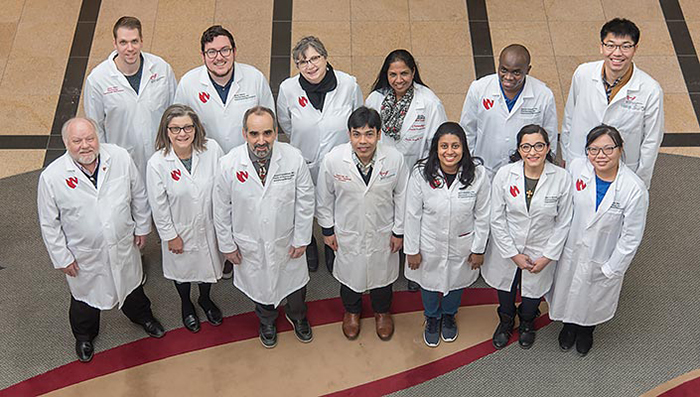For first time ever, researchers able to eliminate HIV from animals

University of Nebraska Medical Center collaborates on historic study
PHOTO: Members of the UNMC research team included: Back row (left-right) – James Hilaire, Brady Sillman, Ph.D., Larisa Poluektova, M.D., Ph.D., Santhi Gorantla, Ph.D., Benson Edagwa, Ph.D., and Hang Su; Front row — R. Lee Mosley, Ph.D., JoEllyn McMillan, Ph.D., Howard Gendelman, M.D., Prasanta Dash, Ph.D., Saumi Mathews, Ph.D., Mary Banoub, and Zhiyi Lin. Missing from photo – Aditya Bade, Ph.D. and Nagsen Gautam, Ph.D.
In a major collaborative effort, researchers at the University of Nebraska Medical Center (UNMC) and Temple University Lewis Katz School of Medicine have for the first time eliminated replication-competent HIV-1 DNA — the virus responsible for AIDS — from the genomes of living animals.
The study, reported today in Omaha and in the journal Nature Communications, marks a critical step toward the development of a possible cure for human HIV infection.
“This achievement could not have been possible without an extraordinary team effort that included virologists, immunologists, molecular biologists, pharmacologists, and pharmaceutical experts,” said Howard Gendelman, M.D., Margaret R. Larson Professor of Infectious Diseases and Internal Medicine, chair of the Department of Pharmacology and Experimental Neuroscience and director of the Center for Neurodegenerative Diseases at UNMC. “Only by pooling our resources together were we able to make this groundbreaking discovery.”
“Our study shows that treatment to suppress HIV replication and gene editing therapy, when given sequentially, can eliminate HIV from cells and organs of infected animals,” said Kamel Khalili, Ph.D., Laura H. Carnell Professor and chair of the Department of Neuroscience, director of the Center for Neurovirology, and director of the Comprehensive NeuroAIDS Center at LKSOM.
Drs. Gendelman and Khalili were senior investigators on the new study.
Current HIV treatment centers on the use of antiretroviral therapy (ART). ART suppresses HIV replication but does not eliminate the virus from the body. Therefore, ART is not a cure for HIV, and it requires lifelong use. If it is stopped, HIV rebounds, renewing replication and fueling the development of AIDS. HIV rebound is directly attributed to the ability of the virus to integrate its DNA sequence into the genomes of cells in the immune system, where it lies dormant and beyond the reach of antiretroviral drugs.
In previous work, Dr. Gendelman’s team used a therapeutic strategy known as long-acting slow-effective release (LASER) ART co-developed by Benson Edagwa, Ph.D., assistant professor of pharmacology at UNMC.
Dr. Khalili’s team used CRISPR-Cas9 technology to develop a novel gene editing and gene therapy delivery system aimed at removing HIV DNA from genomes harboring the virus. In rats and mice, they showed that the gene editing system could effectively excise large fragments of HIV DNA from infected cells, significantly impacting viral gene expression. Similar to ART, however, gene editing cannot completely eliminate HIV on its own.
For the present study, Dr. Gendelman and his team led by Prasanta Dash, Ph.D., instructor of pharmacology, combined its LASER ART strategy with the gene editing system.
LASER ART targets viral sanctuaries and maintains HIV replication at low levels for extended periods of time, reducing the frequency of ART administration. The long-lasting medications were made possible by pharmacological changes in the chemical structure of the antiretroviral drugs. The modified drug was packaged into nanocrystals, which readily distribute to tissues where HIV is likely to be lying dormant. From there, the nanocrystals, stored within cells for weeks, slowly release the drug.
Dr. Khalili said, “We wanted to see whether LASER ART could suppress HIV replication long enough for CRISPR-Cas9 to completely rid cells of viral DNA.”
To test their idea, the researchers used mice engineered to produce human T cells susceptible to HIV infection, permitting long-term viral infection and ART-induced latency. Once infection was established, mice were treated with LASER ART and subsequently with CRISPR-Cas9. At the end of the treatment period, mice were examined for viral load. Analyses revealed complete elimination of HIV DNA in about one-third of HIV-infected mice.
“The big message of this work is that it takes both CRISPR-Cas9 and virus suppression through a method such as LASER ART, administered together, to produce a cure for HIV infection,” Drs. Gendelman and Khalili said in a shared statement. “We now have a clear path to move ahead to trials in non-human primates and possibly clinical trials in human patients within the year.”
“The ability to excise HIV-1 DNA from the genomes of infected animals depends on LASER ART’s abilities to maximally restrict ongoing infection. This concept of combining both modalities provides a pathway forward to future studies in humans,” Dr. Gendelman said.
How you may help
While research breakthroughs such as this rely on critical grant funding, private contributions of every amount also make these scientific discoveries possible. Gifts help provide research equipment and instruments, endowed support for faculty, support for fellowships for graduate researchers, program support and much more.
If you are interested in supporting the lifesaving HIV research underway at the University of Nebraska Medical Center, please consider a contribution to the Community Pride and Distinguished Science Research Fund (01087930). Your gift will enable the Department of Pharmacology and Experimental Neuroscience to continue this important work.
You may give online now or send a check made payable to the University of Nebraska Foundation to: University of Nebraska Foundation, PO Box 82555, Lincoln NE 68501-2555. Please include in the memo line of your check the fund number 01087930.

